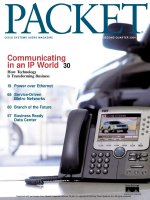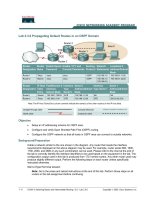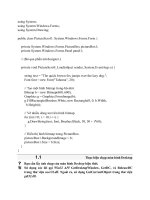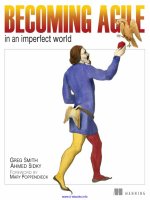Becoming Agile: ...in an imperfect world pdf
Bạn đang xem bản rút gọn của tài liệu. Xem và tải ngay bản đầy đủ của tài liệu tại đây (16.45 MB, 410 trang )
MANNING
in an imperfect world
FOREWORD BY
MARY POPPENDIECK
GREG SMITH
AHMED SIDKY
www.it-ebooks.info
Becoming Agile
Licensed to Deborah Christiansen <>
www.it-ebooks.info
Licensed to Deborah Christiansen <>
www.it-ebooks.info
Becoming Agile
IN
AN
IMPERFECT
WORLD
GREG SMITH
AHMED SIDKY
MANNING
Greenwich
(74° w. long.)
Licensed to Deborah Christiansen <>
www.it-ebooks.info
For online information and ordering of this and other Manning books, please visit
www.manning.com. The publisher offers discounts on this book when ordered in quantity.
For more information, please contact
Special Sales Department
Manning Publications Co.
Sound View Court 3B fax: (609) 877-8256
Greenwich, CT 06830 email:
©2009 by Manning Publications Co. All rights reserved.
No part of this publication may be reproduced, stored in a retrieval system, or transmitted, in
any form or by means electronic, mechanical, photocopying, or otherwise, without prior written
permission of the publisher.
Many of the designations used by manufacturers and sellers to distinguish their products are
claimed as trademarks. Where those designations appear in the book, and Manning
Publications was aware of a trademark claim, the designations have been printed in initial caps
or all caps.
Recognizing the importance of preserving what has been written, it is Manning’s policy to have
the books we publish printed on acid-free paper, and we exert our best efforts to that end.
Recognizing also our responsibility to conserve the resources of our planet, Manning books are
printed on paper that is at least 15% recycled and processed without the use of elemental chlorine.
Development Editor: Nermina Miller
Manning Publications Co. Copyeditor: Tiffany Taylor
Sound View Court 3B Typesetter: Gordan Salinovic
Greenwich, CT 06830 Cover designer: Leslie Haimes
ISBN 978-1-933988-25-2
Printed in the United States of America
1 2 3 4 5 6 7 8 9 10 – MAL – 14 13 12 11 10 09
Licensed to Deborah Christiansen <>
www.it-ebooks.info
v
brief contents
P
ART
1 A
GILE
FUNDAMENTALS
AND
A
SUPPORTING
CASE
STUDY
1
1
■
Moving to agile 3
2
■
The story of Acme Media 17
P
ART
2 G
ETTING
STARTED
25
3
■
Are you ready for agile? 27
4
■
The fitness test: all about readiness assessments 43
5
■
The importance of obtaining executive support 58
6
■
Improving buy-in by creating a core team 66
7
■
The mindset of an agile leader 73
8
■
Injecting agility into your current process 87
9
■
Selecting a pilot project 105
P
ART
3 K
ICKING
OFF
113
10
■
Feasibility: is this project viable? 115
11
■
Aligning the pilot team with the project 136
Licensed to Deborah Christiansen <>
www.it-ebooks.info
BRIEF
CONTENTS
vi
P
ART
4 P
OPULATING
THE
PRODUCT
BACKLOG
151
12
■
Feature cards: a tool for “just enough” planning 153
13
■
Prioritizing the backlog 170
14
■
Estimating at the right level with the right people 183
P
ART
5 E
NOUGH
INFORMATION
FOR
SCHEDULING
193
15
■
Release planning: envisioning the overall schedule 195
16
■
Iteration planning: the nitty-gritty details 204
P
ART
6 B
UILDING
THE
PRODUCT
221
17
■
Start your engines: iteration 0 223
18
■
Delivering working software 230
19
■
Testing: did you do it right? 244
P
ART
7 E
MBRACING
CHANGE
253
20
■
Adapting: reacting positively to change 255
21
■
Delivery: bringing it all together 277
22
■
The retrospective: working together to improve 297
P
ART
8 M
OVING
FORWARD
311
23
■
Extending the new process across your company 313
Licensed to Deborah Christiansen <>
www.it-ebooks.info
vii
contents
foreword
xvii
preface
xix
acknowledgments
xxi
about this book
xxiii
P
ART
1A
GILE
FUNDAMENTALS
AND
A
SUPPORTING
CASE
STUDY
1
1
Moving to agile
3
1.1 Is Agile just another process? 5
The Agile Manifesto and related values 6
■
The agile principles 7
The agile practices 9
1.2 A paradigm shift from a plan-driven mentality 10
1.3 Agile and the bottom line 11
1.4 How this book will help you become more agile 14
1.5 Key points to remember 16
1.6 Looking ahead 16
2
The story of Acme Media
17
2.1 Case study background and circumstances 18
2.2 About the Acme Media teams 19
Licensed to Deborah Christiansen <>
www.it-ebooks.info
CONTENTS
viii
2.3 About the individuals 19
2.4 What does it look like when a team “becomes agile”? 20
The existing process 20
■
A process with more agility 21
■
The
ultimate process 22
2.5 Key points to remember 24
2.6 Looking ahead 24
P
ART
2G
ETTING
STARTED
25
3
Are you ready for agile?
27
3.1 What areas will you become more agile in? 28
Increasing customer involvement 28
■
Improving prioritization of
features 28
■
Increasing team buy-in and involvement 28
Clarifying priorities and reminding everyone of the consequences of
changing them 28
■
Adapting to change during development 29
Better understanding the project’s status 29
■
More efficient
planning and estimating 29
■
Continuous risk management 30
Delivering the project needed at the end 30
■
Achieving the right level
of project structure 30
3.2 The different flavors of agile 32
Scrum 32
■
Extreme Programming 34
3.3 Create your own flavor to become agile within your
constraints 35
Your goal: reach the right level of agility for your organization 36
Characteristics that make agile easier to adopt 38
■
Roadblocks that
others have overcome 40
3.4 Key points to remember 42
3.5 Looking ahead 42
4
The fitness test: all about readiness assessments
43
4.1 The importance of readiness assessments 44
4.2 Reducing the risks of agile adoption using assessments 44
4.3 Increasing productivity during transitions 46
4.4 Getting executive buy-in for agile adoption using
readiness assessments 47
4.5 Conducting readiness assessments 49
Readiness-assessment tables 49
■
Finding out the results 52
Licensed to Deborah Christiansen <>
www.it-ebooks.info
CONTENTS
ix
4.6 Key points 57
4.7 Looking ahead 57
5
The importance of obtaining executive support
58
5.1 Why should we pursue agile? 59
5.2 The cost of migrating 60
5.3 The risks in migrating 61
5.4 Rewards for the executives 62
5.5 Communicating frequently with your executive team 62
5.6 The role of the sponsor 63
5.7 Following Acme Media as the company obtains a sponsor 63
5.8 Key points 65
5.9 Looking forward 65
6
Improving buy-in by creating a core team
66
6.1 Who should be in the core team? 67
6.2 Choosing the core team at Acme Media 68
6.3 The kickoff meeting 69
Tough questions 70
■
Your role in the migration 71
6.4 Key points 72
6.5 Looking forward 72
7
The mindset of an agile leader
73
7.1 The role of an agile coach 75
Attributes of a good coach 75
■
Training and mentoring the core
team 76
7.2 Agile management: more shepherding, less directing 77
Soft skills 78
■
Working with other managers 78
■
Working with
stakeholders 79
■
Demonstrating value 79
■
Leading the team to
ownership 81
7.3 Creating a team with an agile mindset 82
Culture and roles 83
■
Characteristics that influence individual
performance 84
7.4 Key points 86
7.5 Looking forward 86
Licensed to Deborah Christiansen <>
www.it-ebooks.info
CONTENTS
x
8
Injecting agility into your current process
87
8.1 Understanding your current process 88
Documenting the existing process with Acme Media 88
■
Deciding
what to keep: identifying existing valuable practices 91
■
Another
potential tool: documenting a perfect process 93
8.2 Enhancing the existing process 94
Deciding what to change at Acme Media 95
■
Feasibility phase 97
Planning phase 99
■
Development phase 100
■
Adapt phase 101
Deployment phase 102
8.3 Key points 104
8.4 Looking forward 104
9
Selecting a pilot project
105
9.1 Characteristics of a good pilot 107
A project you can complete in 2 to 8 weeks 107
■
A medium-priority
project 108
■
A project that hits all phases and areas 109
■
No
external customers 110
9.2 Evaluating projects at Acme Media 110
Request backlog 110
■
Selecting a pilot project: an example 111
9.3 Key points 112
9.4 Looking forward 112
P
ART
3K
ICKING
OFF
113
10
Feasibility: is this project viable?
115
10.1 Feasibility in the big picture 116
10.2 Selecting a feasibility team 118
Selecting feasibility team members at Acme Media 119
10.3 Introducing the known requirements
to the feasibility team 121
What does a feasibility investigation look like? 124
■
Analyzing an
idea with the Feasibility Discussion Guide 124
■
Feedback from the
Acme Media feasibility team 126
■
Modifying the idea during
feasibility analysis 126
■
Reacting to the feedback 127
■
Team
review of the modified concept 131
■
Regrouping after technical
analysis 131
■
Summarizing the feasibility work 132
10.4 The go/no go decision 132
Licensed to Deborah Christiansen <>
www.it-ebooks.info
CONTENTS
xi
10.5 Alternate feasibility paths 134
What people are talking about 134
■
Feasibility for risk management
vs. go/no go 134
10.6 Key points 135
10.7 Looking forward 135
11
Aligning the pilot team with the project
136
11.1 Identifying the pilot team 137
11.2 Preparing the pilot team 138
Ensure everyone is trained on agile 139
■
Providing a mechanism for
feedback 139
11.3 Envisioning the product 140
Creating an elevator statement 140
■
Introduce the team to the
features 141
■
Common understanding of the features 144
11.4 The tradeoff matrix 145
11.5 Project worksheet 146
Team members 149
■
Objective statement 149
■
Issues and risks 149
Technical considerations 149
■
Stakeholders 149
■
User/customer
benefits 149
■
Highlights 149
■
Major milestones 149
■
Elevator
statement 150
11.6 Key points 150
11.7 Looking forward 150
P
ART
4P
OPULATING
THE
PRODUCT
BACKLOG
151
12
Feature cards: a tool for “just enough” planning
153
12.1 The structure of a feature card 154
The right amount and type of information 156
■
Additional feature-
card benefits
156
12.2 A team approach to creating feature cards 157
Creating a feature card at Acme Media 158
■
Reviewing the feature
cards as a team 160
12.3 Feature cards compared to… 161
User stories 161
■
Use cases 162
■
Functional specifications 163
12.4 Limitations in using feature cards 164
Project complexity 165
■
The customer isn’t available 165
Compliance and traceability 165
Licensed to Deborah Christiansen <>
www.it-ebooks.info
CONTENTS
xii
12.5 Hard-copy cards vs. electronic cards 166
12.6 Key points 168
12.7 Looking forward 169
13
Prioritizing the backlog
170
13.1 The art of prioritizing, sequencing, and grouping features 171
13.2 Prioritizing the backlog at Acme Media 172
Prioritizing by value 174
■
Evaluating risk 175
■
Grouping
related features 178
13.3 Other ways to prioritize features 180
What about technical features? 181
13.4 Key points 181
13.5 Looking forward 182
14
Estimating at the right level with the right people
183
14.1 Contrasting traditional and agile estimation techniques 184
14.2 The importance of whole-team estimation 185
14.3 A step toward agility: estimating size, not effort 187
Using story points for quick estimation 187
■
Planning poker 189
14.4 Estimating story points at Acme Media 189
14.5 Key points 191
14.6 Looking forward 191
P
ART
5E
NOUGH
INFORMATION
FOR
SCHEDULING
193
15
Release planning: envisioning the overall schedule
195
15.1 Defining the pieces of a release plan 196
Iteration 0 length 196
■
Development iteration length 196
■
How
long do you need between iterations? 197
■
Determining the overall
timeline 198
15.2 Completing the release plan by assigning features
to iterations 199
Assigning features to iterations at Acme Media 200
Licensed to Deborah Christiansen <>
www.it-ebooks.info
CONTENTS
xiii
15.3 Communicating the release plan with a kickoff meeting 201
15.4 Key points 203
15.5 Looking forward 203
16
Iteration planning: the nitty-gritty details
204
16.1 Clearly defining the goals: what is “feature
complete”? 204
16.2 Using feature modeling to identify and estimate
tasks 205
Outlining the workflow for a feature 206
■
Discovering new
features 207
■
Outlining the screens for a feature 207
■
Adding
details to a screen by considering user interaction 208
■
Is modeling
worth it? 209
16.3 Identifying and estimating tasks 209
16.4 Determining the hours available in an iteration 211
16.5 Bringing estimates and capacity
together to complete the plan 212
16.6 Making status visible 213
Visibility within an iteration 214
■
Tracking release status 216
Finding tools that work for you 217
16.7 Key points 220
16.8 Looking forward 220
P
ART
6B
UILDING
THE
PRODUCT
221
17
Start your engines: iteration 0
223
17.1 Initial vision for the architecture 224
17.2 Completing contracts with third parties 224
17.3 Preparing environments and support tools 225
17.4 Obtaining funding 226
17.5 Finalizing and dedicating the project team 227
17.6 Cheating: starting the work early 228
17.7 Key points 229
17.8 Looking forward 229
Licensed to Deborah Christiansen <>
www.it-ebooks.info
CONTENTS
xiv
18
Delivering working software
230
18.1 Supporting the agile principles during development
and testing 231
Satisfy the customer through early and continuous delivery of valuable
software 232
■
Have business people and developers work together daily
throughout the project 232
■
Whenever possible, communicate face to
face 232
■
Pay attention to technical excellence and good design 233
Focus on simplicity and the art of maximizing the amount of work not
done 234
■
Welcome changing requirements, even late in develop-
ment 234
■
Test early, and test often 235
■
Continuously integrate
code changes 235
■
Obtain customer feedback as early as possible 235
Minimize team distractions during development iterations 236
18.2 Where to begin? 237
Sequence within an iteration 238
■
Making assignments 238
18.3 Completing a feature 239
What the work looks like 240
■
Other considerations for development
iterations 242
18.4 Key points 242
18.5 Looking forward 243
19
Testing: did you do it right?
244
19.1 Unit testing 245
19.2 Integration testing 246
19.3 Functional testing 247
19.4 Exploratory testing 248
19.5 Test automation 249
19.6 Key points 251
19.7 Looking forward 252
P
ART
7E
MBRACING
CHANGE
253
20
Adapting: reacting positively to change
255
20.1 Common reasons for adapting 256
Feature is larger than expected 256
■
Customer refinement of
requirements 257
■
The business need changes 257
■
A technical
constraint is discovered 258
■
A team member is unavailable 258
A third party doesn’t deliver 259
■
Team throughput is lower than
expected 259
20.2 Adapting during an iteration 260
Licensed to Deborah Christiansen <>
www.it-ebooks.info
CONTENTS
xv
20.3 Three ways Acme Media adapted during its first iteration 261
A change in feature scope 261
■
An issue with performance 262
Underestimating the registration need 262
20.4 Adapting at the end of an iteration 262
Demonstrating and gathering feedback 263
■
Re-evaluating
priorities: what are your options? 263
■
Reviewing team performance
and velocity 265
■
Re-planning and reacting 265
20.5 How Acme Media adapts during adapt week 265
Reviewing the work completed 266
■
Demonstrating the work 267
Personality types and demonstrations 268
■
Demonstrating
incomplete features 269
20.6 User Acceptance Testing 270
Acme Media’s UAT approach 270
■
Output from Acme Media’s UAT 270
20.7 Changes in the business climate 271
20.8 Reviewing the findings and revising the plan for the next
iteration 272
Evaluating team velocity 272
■
New work identified during the
iteration 273
■
Features originally slated for iteration 2 273
20.9 Key points 276
20.10 Looking forward 276
21
Delivery: bringing it all together
277
21.1 When to release 278
To support a constraint 278
■
To meet a predetermined schedule 279
When there is enough value 280
■
To test the product 281
21.2 Final testing 282
What about quality level? 282
■
Completing functional/usability
testing 283
■
Completing the user acceptance process 284
Validation of nonfunctional requirements 284
21.3 Preparing support groups and processes 286
The running maintenance and support worksheet 286
■
Finalizing
help materials and support processes 287
■
Enabling system
monitoring, and creating an escalation process 287
■
Enabling
maintenance and background processes 288
21.4 Communication and training 288
21.5 Ready to release 289
Deciding to go live 289
■
Planning the deployment steps 291
Deployment considerations 291
■
Creating a deployment and
backout plan 292
■
Reducing risk with a pilot 294
Licensed to Deborah Christiansen <>
www.it-ebooks.info
CONTENTS
xvi
21.6 Enough planning; let’s deploy 294
Celebrate! 294
21.7 Key points 295
21.8 Looking forward 296
22
The retrospective: working together to improve
297
22.1 Setting expectations for the retrospective 298
22.2 Time to digest: a survey in advance 300
22.3 Conducting the retrospective meeting 302
22.4 What to expect during the meeting 304
22.5 Converting the feedback into action 307
22.6 Key points 308
22.7 Looking forward 309
P
ART
8M
OVING
FORWARD
311
23
Extending the new process across your company
313
23.1 Common findings after a pilot 314
Slower than the old process 314
■
Confusion about the process 314
Team polarization 315
■
Starting to feel agile 315
23.2 What the Acme Media team learned from their pilot 316
Embracing change to deliver customer value 316
■
Customer involvement
and feedback 317
■
Planning and delivering software frequently 318
Technical excellence 319
■
Human-centric practices 320
23.3 Next steps 322
Spanning the chasm 322
■
Using the SAMI 326
■
Agile practices 330
23.4 Key points 331
23.5 Conclusion 331
appendix A Readiness assessment tables by practice 333
appendix B Agile concepts from a phase perspective 354
appendix C Agile process overview in text 362
appendix D Example: determining process and document needs for a project 365
appendix E Quantitative feedback on the SAMI 368
resources 371
index 373
Licensed to Deborah Christiansen <>
www.it-ebooks.info
xvii
foreword
Over the years I have seen a lot of software development organizations try to become
agile. Some have succeeded beyond their wildest dreams and continue to improve to
this day. But those are the exceptions. In a more typical scenario, agile development
shows some initial success, but once the low-hanging fruit has been picked, it doesn’t
seem to deliver that much sustained value over time. The question is, why does sus-
tained success from agile development seem to be so elusive?
I observe three reasons why agile initiatives seem to plateau:
First, agile development is frequently initiated as a grassroots movement to
develop better software—it is seen as a “developer thing.” Consequently, development
managers and customer organizations are often not on board. This is a mistake,
because dramatic improvements from agile development require a different mindset
on the part of both development managers and the organizations for which the soft-
ware is being developed.
Second, some companies have made serious missteps in applying agile—perhaps
by developing an unmaintainable code base or creating an unsupportable set of
expectations in the minds of development teams or customers. Sometimes an agile
implementation follows a simple recipe that is a bad fit to the company needs; some-
times the implementation is perfect for some people in the company (developers, for
instance), but it doesn’t take into account the needs of others (testers, for example).
Finally, agile development might be considered a silver bullet—a quick and easy fix
to problems that plague software development. In this case, the hard work required to
make agile successful is ignored, and when companies come to the realization that agile
is not going to be as easy as they anticipated, all too often commitment dissipates.
Licensed to Deborah Christiansen <>
www.it-ebooks.info
FOREWORD
xviii
Initiating and sustaining an effective agile development program is a challenging
journey. First, implementation should involve far more than the development team. A
broad array of cross-functional impacts should be considered, not to mention the fact
that agile might well require a different management approach. Second, the technical
practices that agile brings to the table—short iterations, test-first development, contin-
uous integration—are not optional. Ignore them or leave them until later at your own
risk. Finally, nothing, not even agile development, will remove the inherent complex-
ity of software development or its nonlinear escalation with size.
In Becoming Agile, Greg Smith and Ahmed Sidky lay out a path to agile software
development that addresses the typical failure modes. First, they understand that no
environment is perfect, and it is practically impossible to roll out a perfect agile pro-
cess. To compensate for this reality, Greg and Ahmed suggest numerous ways of pursu-
ing the agile principles within the constraints of your business. The book does not ask
you to discard processes that have been successful for you; the authors realize your
existing processes may have many positive aspects. They show you how to convene a
cross-functional steering committee to guide the agile implementation so that it fits
into your organization.
Second, since part of being agile is learning and adapting, Greg and Ahmed show
you how to pilot the new approach. They explain how to select a pilot project and how
to try out the new ideas and adapt them so they work in your context. Through an
extended case study, they show what actually happened in agile deployments they
have led. The case study also introduces real personas so you can see how different
personality types react to a move to agile.
Finally, Greg and Ahmed dispel the notion that agile is a simple recipe that anyone
can learn in a day with guaranteed success. Instead of offering a simple, foolproof for-
mula, this book shows how to thoughtfully introduce agile into a company. After lead-
ing you through a readiness assessment to determine the most logical areas to
introduce agile, Greg and Ahmed take you through assembling a cross-functional lead-
ership team, identifying the best aspects of your current process, designing more adap-
tive processes, carefully choosing a pilot, trying and adapting the process, and gradually
improving and expanding agile processes over time. This strikes me as a more likely
approach to successfully evolve a new development process that fits the company.
The book is full of simple tools that will help people think clearly; it is about readi-
ness, chartering, specifying, estimating, assuring quality, product demonstrations, ret-
rospectives, and so on. By using an extended case study, Greg and Ahmed show you one
example of a migration to agile, all the while pointing out other ways to accomplish the
same objectives. Their book is neither a recipe nor a set of principles. It is a thoughtful,
practical set of steps, presented with commentary and alternatives, about how to become
agile. It will help you put together an agile development approach that matches your
company needs and has a high likelihood of delivering sustained value over time.
M
ARY
P
OPPENDIECK
P
RESIDENT
, P
OPPENDIECK
, LLC
Licensed to Deborah Christiansen <>
www.it-ebooks.info
xix
preface
In 2005 I began teaching an Agile Project Management course at Bellevue Commu-
nity College. Although my students noted I was a bit “wordy,” they appreciated the
real-world case study I used for the course, based on my own agile experiences. I told
the students I had created the course because most available agile training was based
on perfect world explanations of agile practices and the creation of a pure agile envi-
ronment. The case study used in the course showed what it was like to start transition-
ing to agile versus what it looked like after a team had been using agile for many years.
Positive student feedback made me wonder if a book on transitioning to agile
would be of value to the software community. I began searching through the shelves
of Barnes & Noble and through the inventory available on Amazon.com. I was sur-
prised to see that very few books addressed agile migration, and I could not find any
books that demonstrated what the process looked like from day one through the com-
pletion of a pilot project. Maybe it was time to find out if I had any writing skills!
Needless to say, Manning saw the value in the idea and helped me refine the con-
cept. Manning also sought out experts in the agile community who provided unfil-
tered feedback on the first chapters of the book (reviewers, you were anonymous to
us, but we want you to know we appreciate all of your feedback and we worked quite a
bit of it into the book).
As I started writing the book I kept receiving feedback that I needed to discuss agil-
ity levels within an organization. Reviewers wanted a tool for assessing their ability to
use agile and also for measuring their agility at the organization level, similar to the
Capability Maturity Model Integration (
CMMI
). I was not an authority in the assessment
Licensed to Deborah Christiansen <>
www.it-ebooks.info
PREFACE
xx
field, so I sought out an expert and came across Ahmed Sidky, creator of the Sidky Agile
Measurement Index (
SAMI
).
At first I just wanted permission to use Ahmed’s assessment materials, but as we
spoke more on the phone it felt like we were two lost agile brothers who had spent a
lifetime apart. Although our software experiences were completely different, Ahmed
and I were in synch with our core agile beliefs. So much so that Ahmed signed on to
not only provide the assessment content, but also to coauthor and refine the book
with me. He suggested great ways to organize the content and also provided insight
into agile practices where my experience was light. His contribution was invaluable
and helped take the book to another level.
I am proud of our final product and I hope our experiences do help others
become agile.
G
REG
S
MITH
Licensed to Deborah Christiansen <>
www.it-ebooks.info
xxi
acknowledgments
Writing this book has been an exciting journey that brought several incredible people
into my life. I want to thank the entire team who helped with the book’s structure,
content, and presentation. First, thank you to Ahmed Sidky for your superb ideas on
how to organize the book and for the superb content you provided. Your insights on
agile adoption are groundbreaking, and I am honored to work with you. You are a
great partner.
I also want to thank Michael Stephens of Manning for spending weeks working
with me to convert a raw idea into a real book. Your guidance and feedback had a
huge impact on the final product.
We also had a first-class review team for this book. Craig Smith provided solid tech-
nical proofreading and helped us enrich the content for different perspectives. Ner-
mina Miller was the main editor and provided great guidance for connecting with the
reader. You are the best, Nermina!
The final edit team also put the book through several reviews to improve continu-
ity, wording, grammar, and flow. Tiffany Taylor, Linda Recktenwald, and Katie Ten-
nant may need a vacation after correcting all of our typos. Director of Production,
Mary Piergies, did an excellent job of coordinating all of our work and getting the
book into print.
And of course, thank you to Publisher Marjan Bace for taking on this book and
sticking with it as it went down various paths and side roads on the way to final copy.
I would also like to thank all of the people who have shaped my ideas about soft-
ware development throughout my career. Joe Woodmancy, thank you for my first
Licensed to Deborah Christiansen <>
www.it-ebooks.info
ACKNOWLEDGMENTS
xxii
commercial software job. You were a great mentor and provided sound guidance on
application development. Jim Highsmith, you have influenced me more than any
other person. The first class I took from you opened my eyes and allowed me to start
enjoying software projects again. Thank you for the great training and inspiration
you have provided to me. Mary Poppendieck, thank you for providing the foreword
and for pioneering new discoveries and insights in the agile community. I am always
learning something new from your work.
Thank you also to all the reviewers who took time out of their busy schedules to
read our manuscript in different stages during its development. Your feedback was
invaluable. Thanks to John C. Tyler, Robi Sen, Randy Miller, Andrew Siemer, Tariq
Ahmed, Bernard Farrell, Bruno Lowagie, Carlo Bottiglieri, Paul King, Mike Tian-Jian
Jiang, Federico Tomassetti, Robert Dempsey, Patrick Debois, Doug Warren, Horaci
Mcias, Daniel Alford, Amr Elssamadisy, Dave Corun, Bas Vodde, Vincent Yin, Valentin
Crettaz, Marco Ughetti, Darren Neimke, Hannu Terävä, Eric Raymond, Jason Kolter,
Christopher Haupt, Robert Hanson, Dusty Jewett, and Christian Siegers.
Lastly, I thank my family. Thanks to my parents, Darrell and Eva, for providing
unconditional support for whatever endeavor I have pursued. Thanks to my wife,
Peggy, who continued to provide support even after we discovered what it really
means to write a book. And finally, a thank you to my daughter, Lauren, for listening
to me go on and on about agile for years. Although only 10 years old, Lauren now has
the skills necessary to lead any company in its move to agile.
G
REG
S
MITH
First and foremost, I am grateful and thankful to Allah, who blessed me with guid-
ance, health, family, and friends who supported me and helped me through the writ-
ing of this book. I am especially forever grateful to my sisters and beloved parents,
Samy and Hoda, who supported me and encouraged me through every step of my life
to reach where I am today. I am very fortunate to have been blessed with an amazing
and supportive wife, Noura, who has felt both the pain and joy of this book. Thank
you, Noura, for your love and enthusiasm, and I hope you are ready for my next book.
This book could not have happened without the hard work and dedication of my
dear friend and coauthor Greg Smith. I really enjoyed working with him and thank
him for his patience and perseverance.
A
HMED
S
IDKY
Licensed to Deborah Christiansen <>
www.it-ebooks.info
xxiii
about this book
You may be wondering if there is a need for another book on agile. We have dozens of
books on Extreme Programming and Scrum. Areas such as retrospectives, Test Driven
Development, and estimating have been covered well. It seems every subject has been
thoroughly discussed. However, one area that still does not have a lot of coverage is
the actual process of adopting agile. You may find all of the information you need
related to agile practices, but you may have a hard time finding information on how to
go from your existing process to an agile one.
The authors have created this book in the hope of providing more information on
what it takes to move to a more agile process. We have taken all of our migration expe-
riences and rolled them into this book to help you with your own agile adoption. To
make the adoption steps even more tangible, we have created a case study that is an
amalgamation of our experiences. As you follow the case study, you will be reviewing
actual situations that we encountered during migrations and how the companies we
worked with dealt with constraints and cultural change. Real company names are not
used, but the events are real.
Our case study also helps you envision working with different personality types and
experience levels during a migration to agile. We will introduce several personas at
the start of the pilot project, and you will see how the personas react to the process
and cultural changes of an agile environment.
The approach we outline in this book is based on five key observations we have
made:
Licensed to Deborah Christiansen <>
www.it-ebooks.info
ABOUT
THIS
BOOK
xxiv
■
Moving to agile is not a straightforward process. Every organization has unique
constraints it must address.
■
Adopting agile can be risky and even harmful if done incorrectly.
■
Many teams try to use popular agile practices before they are ready for them.
They believe they “are not agile” if they are not using techniques such as Test
Driven Development or Pair Programming.
■
Many teams rush to adopt agile practices without properly embracing the agile
values and principles. They assume “that’s how we become agile.”
■
Many teams start from scratch when moving to agile, discarding legacy practices
that may have been effective and valuable in their environment.
We address these five discoveries with the following approach.
First, we understand the realities of constraints within a company. We have wit-
nessed agile constraints such as
■
Distributed teams
■
The need to support production operations in parallel with projects
■
Compliance and regulatory constraints
■
Limited employee experience
■
Limited customer availability
■
And many more
To support these realities we will walk you through a process of reviewing your existing
process and performing an assessment/survey of your company culture and maturity.
This process will allow you to identify many barriers before you begin your migration,
and you can make an informed decision about which constraints to accept and which
ones to challenge as you move to agile.
Second, we have witnessed the risks associated with moving to agile. We have seen
product delivery jeopardized, and we have seen employees become upset with a
change to the development process.
To minimize these risks we will guide you through a process that involves the devel-
opment team in the migration. Any concerns the team has with the new process will be
taken into account because the team will be involved in creating the new agile process
for your company. Involving the team will also help you create an agile lifecycle that
should flourish in your environment. Your team is closest to the work, and they will
know how things work today and in which areas a change could introduce high risk.
Related to the third observation and the desire to use popular practices, the assess-
ment tool we provide will help you determine which practices the team, company, and
customer can support. We will not encourage you to pursue the most trendy or popular
practices. Instead we will ask you to select practices that add value for your situation.
Concerning the fourth item and the desire to become agile overnight, we have
seen many companies try to shotgun agile in, attempting to get through the pain as
quickly as possible. While there are situations where this makes sense, it can be a risky
Licensed to Deborah Christiansen <>
www.it-ebooks.info









